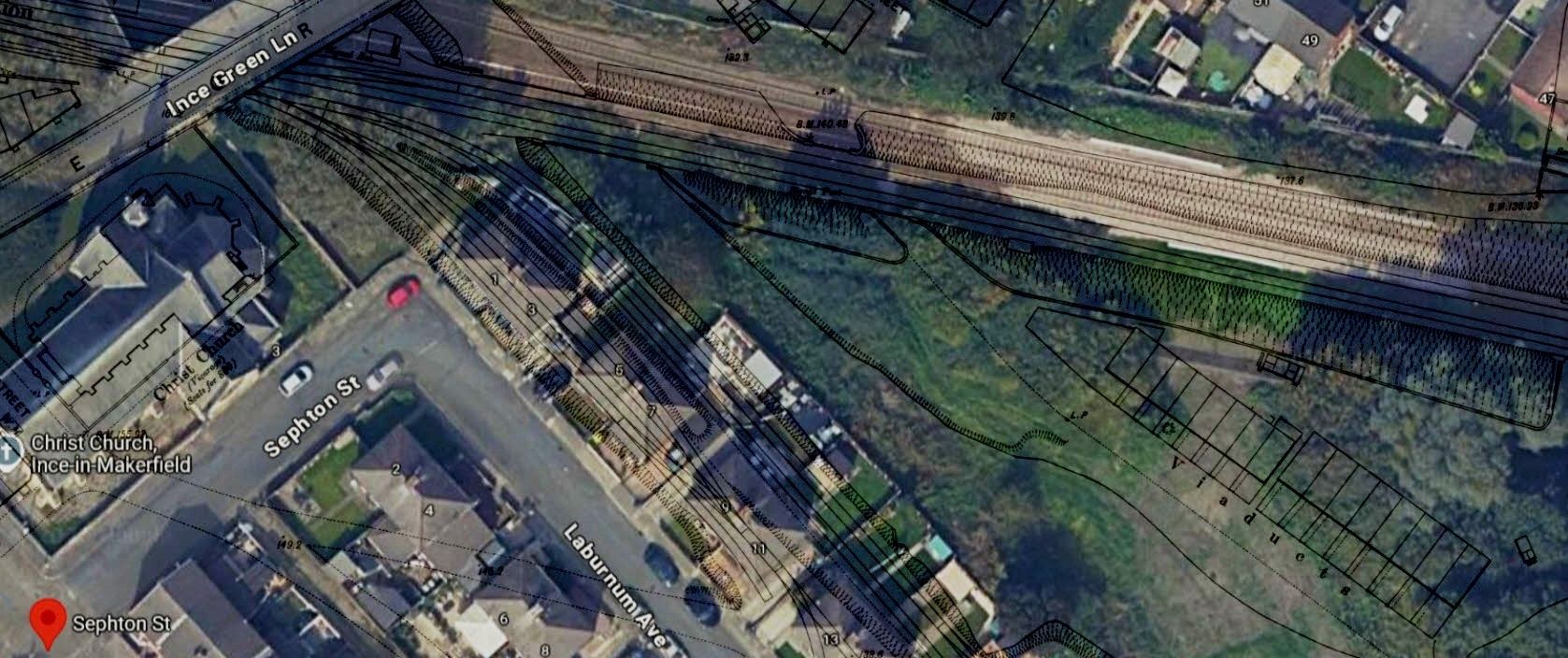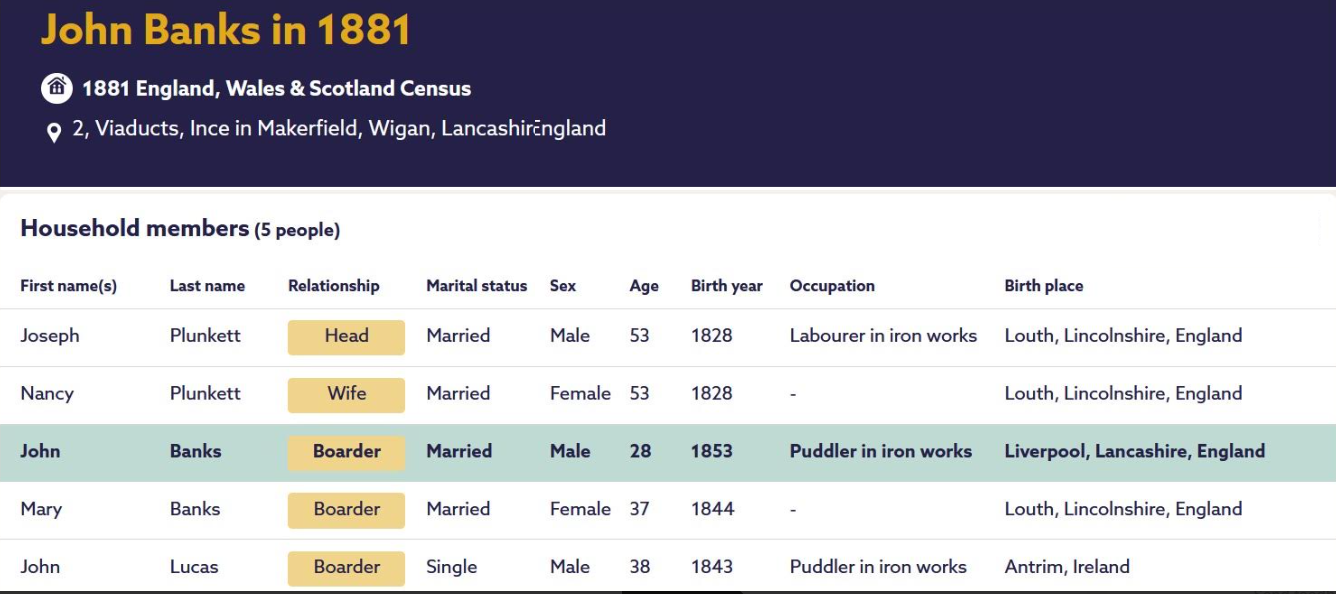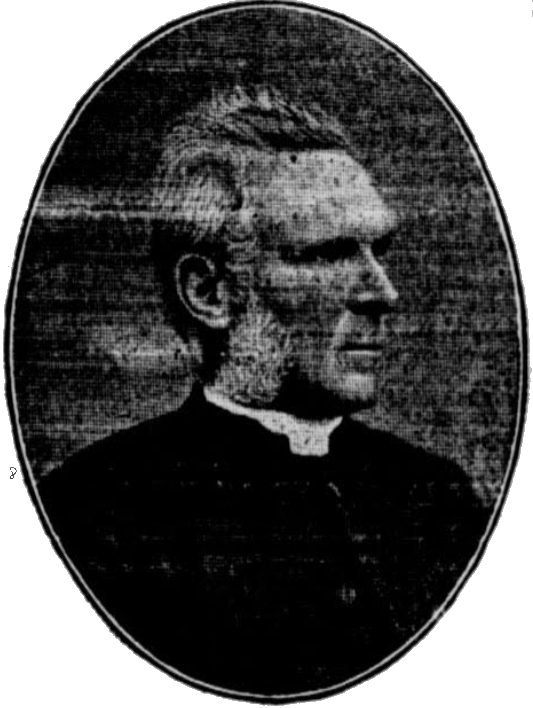1883 - A curious case of a collapsed mineshaft at Ince

It was a late Thursday evening on the 15th March 1883 when the tragic event occurred. John Banks of ‘Viaduct Houses’, Ince-in-Makerfield was swallowed up by a collapsed mineshaft just yards from his home.
These houses formed two rows each containing eight parallel with the branch canal. Dividing the two rows of houses is a narrow passage about a yard wide. One of the houses adjoining this passage had been built upon an arch which crossed over an old upcastmineshaft once belonging to William Gidlow who also owned the two rows of houses.

VIADUCT HOUSES 1890 MAP OVERLAY
A heavy but not a very loud noise was heard when the arch had given way and the front portion of the house to fell down the shaft with a crash. The house was tenanted by an old man named Peter Plunkett, his wife, and a family of six children.
He was saved although his son-in-law John Banks who resided next door but one was just passing Plunkett’s door at the moment when the collapse happened, taking him down along with the front portion of the house. The middle house was occupied by Abraham Clarke and two children who were rescued without sustaining any injury.
John Banks was originally from Liverpool and worked as a puddler in a local iron works. This was a skilled job working with wrought iron. His wife Mary Banks nee Plunkett was nine years his senior whose own family came from Louth, Lincolnshire, no doubt settling in Ince for the work.
Mary was suffering from near blindness at the time and had a narrow escape as she was leaving the house with a can and would have walked straight in to the collapsed mineshaft had a resident not warned her. This suggests that Mary had no idea what had taken place or the demise of her husband.

1881 CENSUS
Three of the houses were vacated immediately after resident James Marsden informed them of the situation. The shaft was then railed off to avert any more accidents. Fire would be burned all night to keep light on the mineshaft as portions of earth continued to give way.
The day after men were employed in securing the place in order to prevent any further mishap and make preparations for recovering Banks’ body. A large number of persons visited the spot to watch the operations that were being carried on.
A couple of weeks later a service was held at the scene led by Canon Fergie assisted by his curate Thomas Taylor. The latter would become the first vicar at St. Mary’s in Lower Ince and at the time was the son-in-law of the Canon.
The family had already consented to the shaft being filled up and realised that any attempt to rescue the body was too dangerous. The service was held on a Wednesday evening at 6.30pm with a large crowd who had assembled.

Canon Fergie
Prior to the blessing, Canon Fergie addressed the assembled crowd and said :-
“As soon as the sad accident happened which entombed our dear brother departed, the owner of this property wisely and prudently consulted a number of able, well-known, and reliable engineers, including a gentleman generally regarded as representing the working men, to ascertain what, if any, steps should be taken with a view to the recovery of the body.
After careful examination and consultation, it was unanimously decided that the attempt at recovery could not be made without imperilling human life.
Reluctant, however, to fill up the hole if there was the slightest chance of recovering the body, the owner of the property considerately allowed the matter for a time to stand over, until finding that the opinion of the engineers was confirmed, and that it would be dangerous in the extreme to re-open the old shaft, it was finally covered in, and some of you are aware that whilst the men were engaged in filling up the hole, a further subsidence took place, the clay in the hole suddenly sinking some four or five feet, breaking a good many of the balks of timber that were placed across the top, and carrying what remained of the front wall of the two cottages down into the shaft.
The soundness and wisdom of the engineers was apparent. If they had been trying to re-open the shaft again when this happened there would doubtless have been a still further loss of life.
The widow whilst recognising the danger of attempting to recover the body and acquiescing in the decision to close the shaft, was naturally wishful that the accidental interment should be followed by some Christian rite and ceremonial”.
A short hymn was then sung before the crowd dispersed.
A. Lomax
Sources:
1) Wigan Examiner 17th March 1883 ‘MAN AND HOUSE ENGULFED BY AN OLD COAL PIT AT INCE’
2) Prescot Reporter and St. Helen’s General Advertiser 19th May 1883 ‘SINGULAR FUNERAL SERVICE AT INCE’
3) Findmypast website 1881 census for Ince-in-Makerfield
4) Google Maps for bird’s eye view of where Viaduct Houses once stood.
5) Wigan Local Studies for image of Canon Fergie
6) Old maps website by the National Library of Scotland for 1890 map
Appreciations:
1) Gwynn Owen